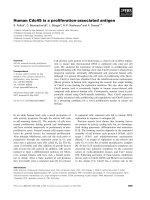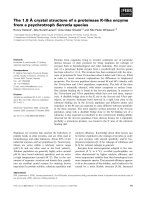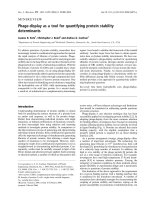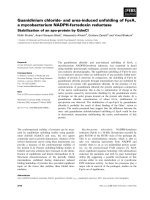báo cáo khoa học: " Upper eyelid reconstruction: a short report of an eyelid defect following a thermal burn" pdf
Bạn đang xem bản rút gọn của tài liệu. Xem và tải ngay bản đầy đủ của tài liệu tại đây (264.3 KB, 3 trang )
BioMed Central
Open Access
Page 1 of 3
(page number not for citation purposes)
Head & Face Medicine
Short report
Upper eyelid reconstruction: a short report of an eyelid defect
following a thermal burn
Francesco Inchingolo*
1
, Marco Tatullo
1
, Fabio M Abenavoli
2
,
Massimo Marrelli
3
, Alessio D Inchingolo
1
, Roberto Corelli
1
,
Angelo M Inchingolo
1
and Gianna Dipalma
1
Address:
1
Department of Dental Sciences and Surgery, General Hospital, Bari, Italy,
2
Department of Otorinolaringoiatry, Hospital
"Fatebenefratelli", Rome, Italy and
3
Department of Maxillofacial Surgery, Calabrodental, Crotone, Italy
Email: Francesco Inchingolo* - ; Marco Tatullo - ; Fabio M Abenavoli - ;
Massimo Marrelli - ; Alessio D Inchingolo - ; Roberto Corelli - ;
Angelo M Inchingolo - ; Gianna Dipalma -
* Corresponding author
Abstract
While the principles of eyelid reconstruction are well-established, achieving good functional and
aesthetic reconstruction remains challenging.
This communication presents a technique that we used on a young patient with an eyelid defect
following a thermal burn. The patient was operated on to reconstruct the entire upper eyelid using,
as a posterior lamella, a mucochondrial autologous graft taken from the ala of the nose as a tarsus
and conjunctiva substitutes that were sutured to the Elevator palpebrae superioris aponeurosis and
muscle. On the other hand, to reconstruct the anterior lamella, which consists of skin and muscle,
the surgeons used a myocutaneous temporal flap taken from the region immediately lateral to the
external canthus of the palpebral region, and which, after being isolated following a drawing of the
upper eyelid to be reconstructed, was rotated and then sutured to the posterior lamella using the
orbicularis oculi muscle as a pedicle.
Introduction
While the principles of eyelid reconstruction are well-
established, achieving good functional and aesthetic
reconstruction remains challenging (1).
A variety of techniques are now available, depending on
the type of lesion and its cause. This communication
presents a technique that we used on a young patient with
an eyelid defect following a thermal burn, which we
recently encountered.
Case Report
The 37 year-old patient from a small town in northern
Italy, was welding when he was hit by a spray of liquid
metal on the periorbital region that burned the upper eye-
lid and part of the lower eyelid. The patient was treated by
eye-specialists at the local hospital with multiple debride-
ments of the palpebral lesions, that take several weeks to
heal, save for the complete loss of the upper eyelid, albeit
partially maintaining the medial and lateral canthus,
along with a loss of the ciliary margin of the entire lower
Published: 25 November 2009
Head & Face Medicine 2009, 5:26 doi:10.1186/1746-160X-5-26
Received: 10 October 2009
Accepted: 25 November 2009
This article is available from: />© 2009 Inchingolo et al; licensee BioMed Central Ltd.
This is an Open Access article distributed under the terms of the Creative Commons Attribution License ( />),
which permits unrestricted use, distribution, and reproduction in any medium, provided the original work is properly cited.
Head & Face Medicine 2009, 5:26 />Page 2 of 3
(page number not for citation purposes)
eyelid. In the weeks which followed, the inflammation of
the eyeball, which was undamaged by the metal but irri-
tated due to a lack of palpebral protection, worsened fur-
ther, partially compromising the eye's functionality. So,
surgery was scheduled to reconstruct the eyelid in a single
operation, because of the distance the patient had to
travel, which would also provide satisfactory functional
and aesthetic results. The patient was operated on to
reconstruct the entire upper eyelid using, as a posterior
lamella, a mucochondrial autologous graft taken from the
ala of the nose as a tarsus and conjunctiva substitutes that
were sutured to the levator palpebrae
superioris aponeurosis and muscle. On the other hand, to
reconstruct the anterior lamella, which consists of skin
and muscle, the surgeons used a myocutaneous temporal
flap taken from the region immediately lateral to the
external canthus of the palpebral region, and which, after
being isolated following a drawing of the upper eyelid to
be reconstructed (Fig. 1), was rotated and then sutured to
the posterior lamella using the orbicularis oculi muscle as
a pedicle. The donor area was closed, following the ample
undermining of the edges, with a linear scar (hardly
noticeable) on the temporal area. The incision performed
on the lower palpebral rim, necessary for the preparation
of the orbicularis muscle as a myocutaneous temporal
flap, was used to place a composite graft taken from the
right auricular concha in order to lift and provide greater
support for the lower eyelid. The patient's postoperative
recovery was normal, and within 7 days he was able to
return home, to be cared for once more by local eye-spe-
cialists in continuing his medical treatment of the eyeball.
When the patient returned two months later for a check-
up, the aesthetic and functional result appeared satisfac-
tory. In fact, the new upper eyelid with a stable lid margin
could open and close properly in spite of the ongoing
presence of residual edema (Fig. 2 a-b).
Discussion
We, thus, consider the possible use of the myocutaneous
temporal flap as a substitute for the anterior lamella of the
upper eyelid in the reconstruction of the complete eyelid
to be extremely satisfactory. Thanks to the fact that the
orbicularis oculi muscle beyond the orbital margins cov-
ers the surface of the frontalis, temporalis, and other mus-
cles, this pedicle, previously mentioned by Yoshimura et
al. in 1991 (2), provides the possibility of further transfer-
ring orbicularis muscle to the missing area when it is not
possible to use the lower eyelid as a donor area, with skin
whose characteristics are similar to those of the upper eye-
Postoperative result two months later, with palpebra that can move up (2a) and down (2b)Figure 2
Postoperative result two months later, with palpebra that can move up (2a) and down (2b).
A
B
Drawing of the orbicularis oculi myocutaneous flap and surgi-cal incisionsFigure 1
Drawing of the orbicularis oculi myocutaneous flap
and surgical incisions.
Publish with Bio Med Central and every
scientist can read your work free of charge
"BioMed Central will be the most significant development for
disseminating the results of biomedical research in our lifetime."
Sir Paul Nurse, Cancer Research UK
Your research papers will be:
available free of charge to the entire biomedical community
peer reviewed and published immediately upon acceptance
cited in PubMed and archived on PubMed Central
yours — you keep the copyright
Submit your manuscript here:
/>BioMedcentral
Head & Face Medicine 2009, 5:26 />Page 3 of 3
(page number not for citation purposes)
lid and with absolutely sure vascularization since it con-
tains branches of the angular artery and the infraorbital
artery in its pedicle. Making use of a muco-cartilaginous
graft taken from the ala of the nose is also advantageous,
since it reproduces the firmness and features of the poste-
rior lamella formed by the tarsal plate and the conjunc-
tiva, without altering either the functionality or the
aesthetics of the ala of the nose.
Conclusion
We, therefore, believe our experiences, which can easily be
reproduced in cases of total or subtotal full-thickness
defects of the upper eyelid, will be of interest.
Consent
Written informed consent was obtained from the patient
for publication of this case report and accompanying
images. A copy of the written consent is available for
review by the Editor-in-Chief of this journal.
Competing interests
The authors declare that they have no competing interests.
Authors' contributions
FI: conceived of the study and participated in its design
and coordination; MT: drafted the manuscript and partic-
ipated in the design of the study; FMA: conceived of the
study and participated in its design and execution; MM:
participated in the design of the study; ADI: revised the lit-
erature sources; RC: participated in design and execution
of the study; AMI: documented surgery with digital pic-
tures; GD: participated in the design of the study; All
authors read and approved the final manuscript.;
References
1. Di Francesco , Lisa MMD, Codner , Mark AMD, McCord , Clinton
DMD: Upper Eyelid Reconstruction. Plastic & Reconstructive Sur-
gery 2004, 114(7):98e-107e.
2. Yoshimura Y, Nakajima T, Yoneda K: Reconstruction of the
entire upper eyelid area with a subcutaneous pedicle flap
based on the orbicularis oculi muscle. Plastic & Reconstructive
Surgery 1991, 88(1):136-9.









